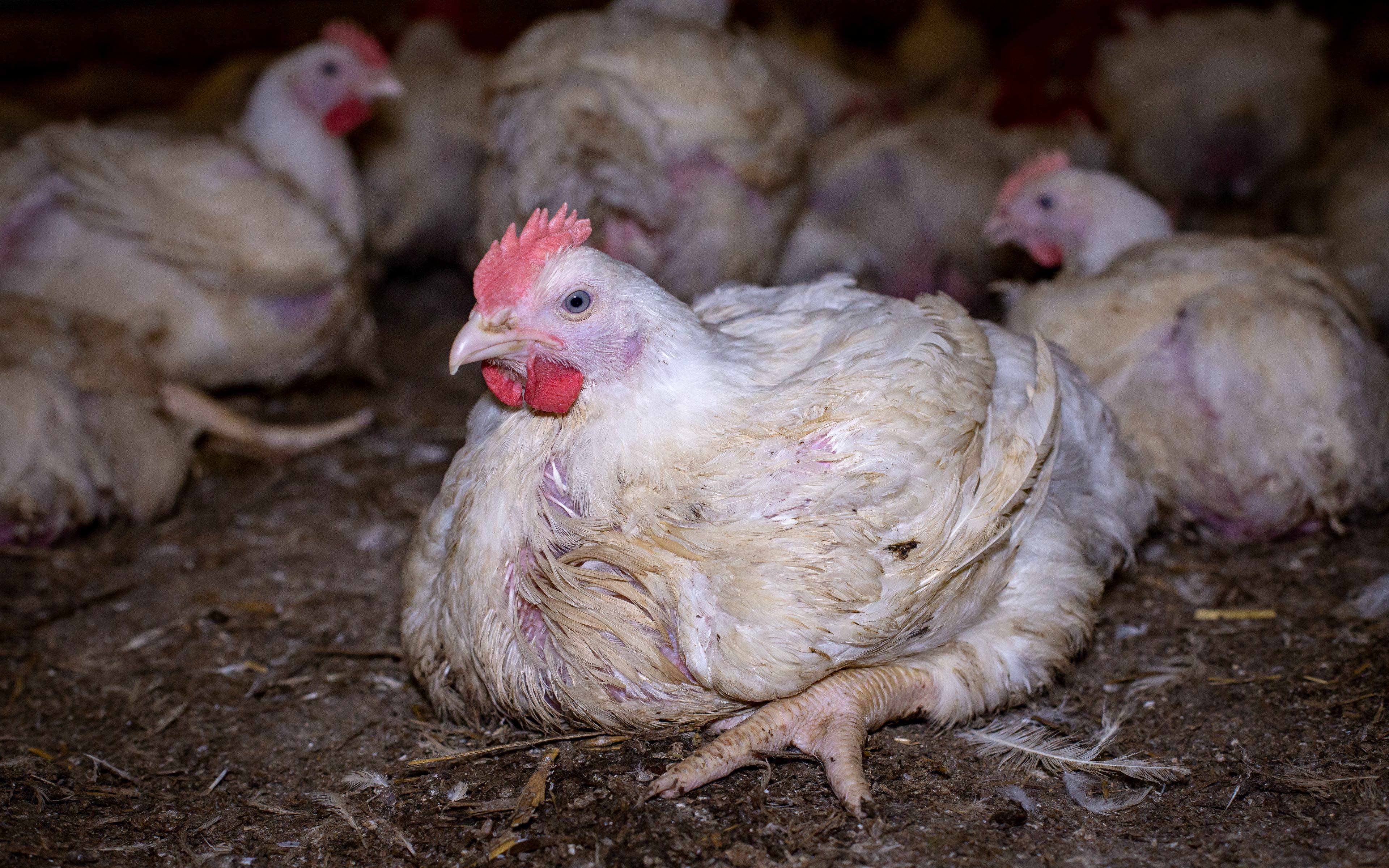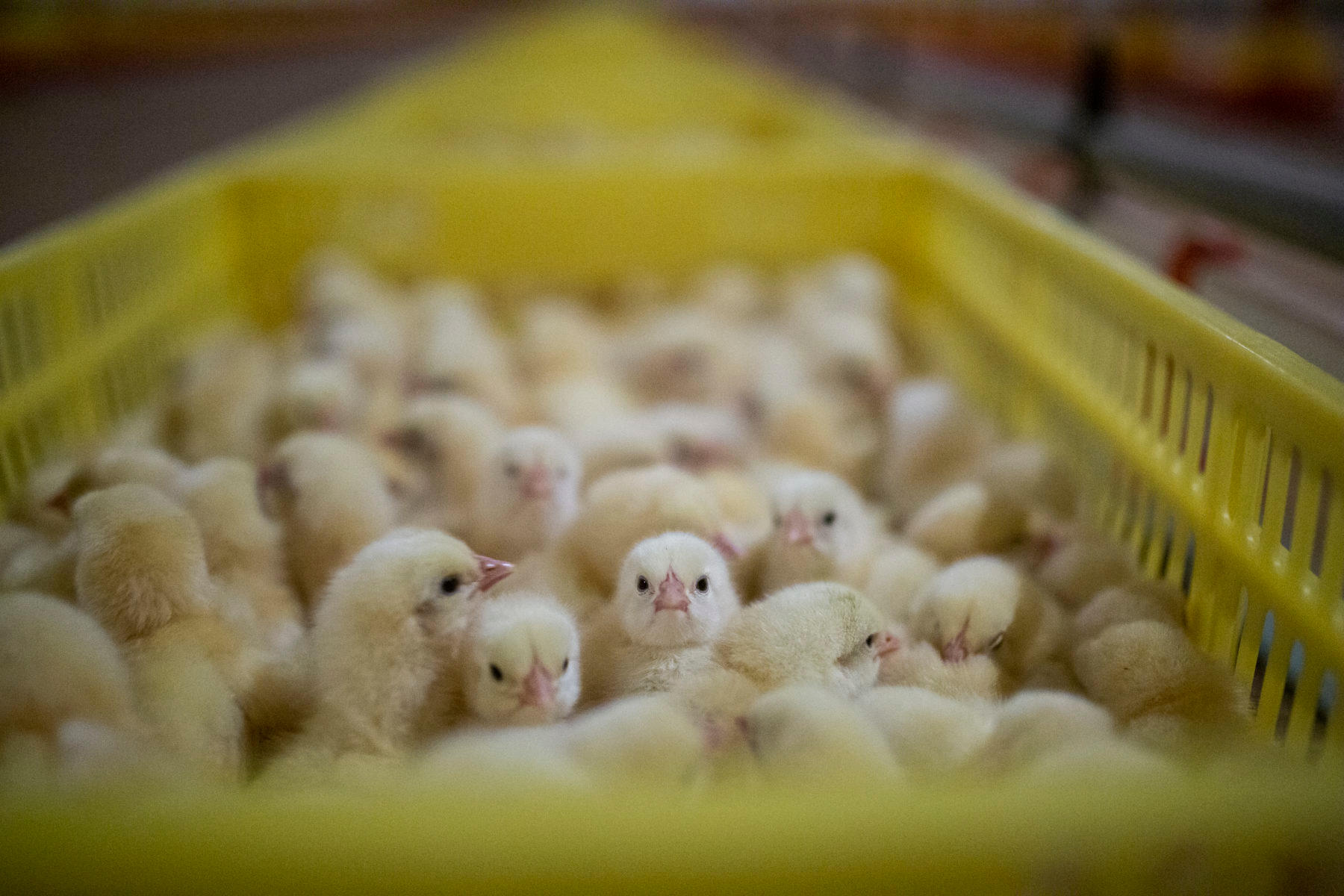




Chickens are the most farmed land animal across the globe, raised and killed in unimaginable numbers. But just how many are killed in the UK each day?

How many chickens are killed per day in the world?
More chickens are killed globally than any other land animals. An astonishing 202 million chickens are killed each day, or about 140,000 per minute.
The vast majority also suffer from the moment they are hatched. In the UK, most chickens raised for meat—also known as broiler chickens—have been genetically selected to grow at such a fast pace that their bodies can’t keep up, leading to heart or leg issues.
Most are also forced to live in conditions that are overcrowded and lack adequate enrichment. While UK farmers and policymakers love to tout British high-welfare standards, in reality, chickens are suffering on farms. And ultimately, each one is killed long before the end of their natural lifespan.
How many chickens are killed per day in the UK?
In the UK specifically, over a billion chickens are killed every year, which translates to just over 287,000 chickens per day.
But it’s not only adult birds being slaughtered. Every day, roughly 110,000 chicks are killed by the UK egg industry, simply because they’re male and don’t lay eggs. When considered annually, that number jumps to 40 million.
How are chickens killed?
From transportation to the place of their slaughter causing fear and exacerbating health issues, to the pain and distress of slaughter itself, chickens endure intense suffering in the final stages of their life.
Transport
In order to be transported to the slaughterhouse, workers typically cram chickens—even those branded free-range, cage-free, or organic—into crates that are then loaded onto large trucks.
Chickens, already fearful of humans, are most often picked up by the legs and carried upside down.
In standard UK transportation vehicles, journey times are restricted to a maximum of eight hours. However, in vehicles with additional requirements, journey times can be even longer. In practice, this means animals can be in transit for well over eight hours, sometimes in extreme temperatures.
Stunning
With few exceptions for religious slaughter such as halal, chickens must be stunned (rendered unconscious) before slaughter. Two common methods are gas or electrical baths.
Depending on the type of the type of gas used, this method can both stun and kill the birds without removing them from the crate. Gas is the most common method used in the UK, as it’s considered more effective than the electrical bath.
The electrical bath involves hanging birds upside down by shackles on their legs. The line of shackles then runs over electrified water where the birds’ heads enter the bath causing them to be electrocuted. A major concern regarding this method is that birds can lift their heads and avoid being stunned, leaving them fully conscious of what comes next. In addition, hanging upside down by their legs is both stressful and painful.
Slaughter
As mentioned, the most common method of slaughtering chickens in the UK is with gas. Chickens remain in their transport crates and oxygen in the air is replaced with argon, nitrogen, or another gas or mixture. This is considered the most humane way to kill chickens.
Alternatively, chickens are killed by having their throats slit. This happens following electrical stunning. While the chickens are shackled upside down on the conveyor belt, following the water bath, a mechanical blade then slices through the major blood vessels in the chickens’ necks.
If chickens are still conscious when they approach the blade, they can again miss this leaving them alive and conscious for what comes next.
Plucking
After being killed, birds are then dunked into scalding water to make the removal of their feathers easier. There is a chance that some chickens will still be alive and conscious by this point and it is unimaginable how terrifying and painful this death would be.
Eviscerating
After slaughter, the chicken’s body is processed. This includes evisceration, where the organs are removed, often by hand.
Alternative methods of killing chickens
Non-stun slaughter (religious slaughter)
While UK law requires that animals be stunned before slaughter, exceptions are made on religious grounds for halal and kosher meat. This means that chickens slaughtered using shechita (Jewish) and halal (Muslim) slaughter methods can have their throats slit while still conscious.
However, while chicken sold as kosher is never pre-stunned, 2018 figures from the Food Standards Agency (FSA) show that 58% of all halal meat in the UK was pre-stunned.
Manual cervical dislocation
Chickens can sometimes be killed by having their necks manually twisted, which the industry calls cervical dislocation. In the UK, this method is only allowed for birds smaller than 3kg.
Grinding up chicks alive
Male chicks in the egg industry are considered worthless because they don’t lay eggs, and are killed shortly after hatching. In the UK this is done through gassing. Elsewhere in the world, this is often done through maceration, meaning grinding them up alive.
What are the ethical implications of killing chickens?
Long considered little more than egg-laying or meat-making machines, research is increasingly revealing how intelligent chickens truly are.
Like us, chickens form friendships, communicate, and even do math. They are maternal, forging bonds with their chicks even in the egg.
As we learn more about our feathered friends, questions about the way they are treated on factory farms become even more prevalent. While we know that people aren’t going to stop eating chickens overnight, we can take incremental steps toward better lives, and deaths, at the hands of the farming industry.
What are the benefits of reducing chicken consumption?
Reducing how much meat we consume benefits the planet, people, and animals. Factory farms not only confine animals to conditions that cause stress and pain, but they are also drivers of disease, antibiotic resistance, and pollution.
Less land use, more biodiversity
If the UK and other top meat-consuming countries cut meat consumption by just a third, we’d free up land equivalent in size to India. That land could be rewilded, a solution many experts are increasingly regarding as a better climate action than tree planting, as the action supports the return of native species.
Benefits for the climate
Eating chicken is often touted as the greener choice because poultry production is less harmful for the planet than beef production. However, the reality is that chicken still has a greater eco-impact than plant foods. For every pound of chicken, 6 pounds of greenhouse gases are also produced.
Less antibiotic resistance
Antibiotic resistance is a growing concern among healthcare experts. 1.27 million people were killed by antibiotic-resistant bacteria in 2019, with the EU accounting for 35,000 of those deaths. While part of the problem is the heavy use of antibiotics in human medicine, animal agriculture makes the issue notably worse. A whopping 73% of antibiotics sold globally are used for livestock. While some of that is used to treat infections in animals, a lot goes toward preventing infections and, outside the UK, even encouraging production.
Lower risk of pandemics
Even before the emergence of COVID-19, factory farms have long faced scrutiny from scientists who warn that these spaces are likely to be sources of future pandemics.
Of particular concern is bird flu, which has already decimated flocks globally. While the virus has only spread to a handful of humans, factory farms are the perfect place for that jump to become more common, due to the contact between birds and staff, and the low genetic diversity of the flocks.
Less animal suffering
One of the most obvious benefits of reducing meat consumption is less animal suffering. Each year, billions of animals in the UK suffer and are eventually killed in the name of meat, egg, and dairy production.
The bottom line
Chickens deserve better. We’re working hard to eliminate the worst suffering they are forced to endure. That’s where the Better Chicken Commitment (BCC) comes in. It’s a set of criteria including giving chickens more space and enrichment (to allow chickens to act like chickens) and eliminating fast-growing breeds.
Hundreds of companies have signed on, promising to rid their supply chains of the worst suffering. But we’re not done yet. We’re continuing to pressure some of the biggest food companies, as well as ensuring current signatories follow through on their promises. We won’t give up until we end the abuse of animals raised for food.






